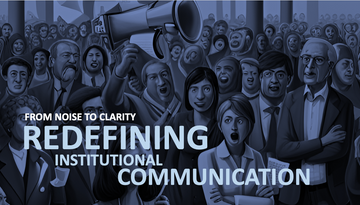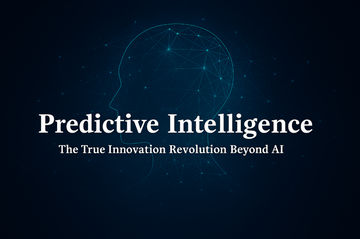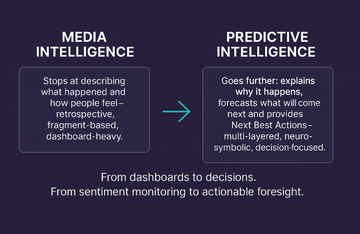
From Noise to Clarity
In today's hyperconnected world, where information overload is the norm, effective institutional communication has become more critical than ever. Cutting through the noise and delivering messages that resonate is key to capturing attention, fostering meaningful connections, and driving business success. We move from 1-2-1 communication to 24/7 All-2-All (A2A) interaction. We move from communication channels to interaction arenas. We need to move from reaction to predictive interaction intelligence as I describe it in my latest book on Reengineering Corporate Communication. In this thought-provoking blog article, we will explore the challenges faced in the realm of business communication, discuss the importance of clarity, and provide actionable strategies to redefine communication practices for maximum impact.
I. The Rising Tide of Communication Noise
In a world inundated with endless streams of information, businesses face the challenge of rising communication noise. The sheer volume of messages, advertisements, and content bombarding individuals on various platforms can be overwhelming. This noise poses a significant hurdle for businesses striving to stand out and effectively convey their messages to their target audience.
-
The Information Overload Dilemma
The availability of vast amounts of information at our fingertips can be both a blessing and a curse. With an overload of data, it becomes challenging for individuals to discern what is truly valuable and relevant. Businesses must navigate this dilemma by providing concise, clear, and meaningful communication that cuts through the noise. -
The Impact of Digital Channels
The proliferation of digital channels, such as social media, email, and instant messaging, has revolutionized the way we communicate. However, the ease of communication has led to an overcrowded digital space where messages often get lost in the sea of notifications. It is essential for businesses to find ways to break through this clutter and engage their audience effectively. -
The Rise of Attention Fragmentation
Attention spans have drastically decreased in the digital age, thanks to constant distractions and multitasking. Businesses need to adapt their communication strategies to capture and maintain the fleeting attention of their audience. Crafting compelling messages that resonate quickly and leave a lasting impact is crucial in an era of attention fragmentation.
II. The Power of Clarity in Institutional Communication
Amidst the noise, clarity emerges as a powerful tool for effective business communication. Clear and concise messages cut through the clutter, grab attention, and make a lasting impression. By embracing clarity, businesses can ensure that their communication resonates with their target audience, leaving no room for misinterpretation or confusion.
-
Cutting Through the Clutter: Less is More In a world bombarded with information, brevity is key. Communicating with conciseness and precision allows messages to be easily understood and retained. By distilling complex ideas into simple, digestible concepts, businesses can grab attention and engage their audience effectively.
-
Crafting a Compelling Value Proposition clearly articulating the value that a product or service offers is essential for successful business communication. Businesses need to communicate how their offerings solve problems, fulfill needs, or enhance the lives of their customers. By highlighting the unique benefits and value proposition, businesses can differentiate themselves from competitors and capture attention.
-
The Role of Visual Storytelling in Enhancing Clarity Visuals have a powerful impact on communication. Incorporating visual elements, such as infographics, images, and videos, helps convey complex information in a visually appealing and memorable way. Visual storytelling captivates audiences, enhances understanding, and leaves a lasting impression.
III. Building Authentic Connections through 24/7 Predictive Interaction Intelligence
Effective business communication goes beyond delivering messages—it is about building authentic connections with the target audience. Authenticity fosters trust, establishes credibility, and cultivates long-term relationships.
-
The Importance of Emotional Resonance: Emotionally resonant communication is key to forging strong connections with the audience. Businesses need to tap into the emotions, values, and aspirations of their target audience to create meaningful experiences. By understanding their audience's pain points, desires, and motivations, businesses can craft messages that evoke genuine emotions and establish deeper connections.
-
Nurturing Trust and Credibility: Trust is the foundation of any successful relationship, and business communication is no exception. Consistency, transparency, and honesty are essential elements in building trust. Businesses must deliver on their promises, be transparent in their communication, and prioritize ethical practices to nurture trust and credibility.
-
Leveraging Interactive Communication: Channels The advent of social media and interactive digital platforms has transformed communication from a one-way street into a dialogue. Businesses must actively engage with their audience, respond to feedback, and foster conversations. By embracing interactivity, businesses can create a sense of community, strengthen relationships, and foster loyalty.
IV. Strategies for Clear and Impactful Institutional Interaction
To redefine business communication for maximum impact, organizations need to adopt strategies that enhance clarity, engage the audience, and drive meaningful action.
-
Crafting Concise and Memorable Messages
By distilling complex ideas into concise and memorable messages, businesses can ensure that their communication leaves a lasting impact. Utilizing storytelling techniques, metaphors, and powerful language helps create messages that resonate and are easily remembered. -
Tailoring Communication to Different Audiences
Understanding the diverse needs and preferences of different audience segments is crucial for effective communication. Tailoring messages to specific target groups, considering their demographics, interests, and pain points, enables businesses to connect on a deeper level and deliver personalized experiences. -
Embracing the Power of Storytelling
Stories have a unique ability to captivate and engage audiences. By incorporating storytelling into business communication, organizations can evoke emotions, inspire action, and create memorable experiences. Sharing success stories, customer testimonials, and narratives that align with the brand's values helps build an emotional connection with the audience. -
Utilizing Visuals for Enhanced Understanding
Visuals have the power to communicate complex information quickly and effectively. Utilizing visual aids, such as infographics, charts, and diagrams, enhances understanding and engagement. Businesses should leverage visual elements to complement their messages and create a more engaging communication experience.
Conclusion
In a world filled with communication noise, clarity stands as a beacon of effective business communication. By cutting through the clutter, businesses can capture attention, build authentic connections, and drive meaningful action. By embracing clarity, authenticity, and interactive channels, organizations can redefine their communication practices and make a lasting impact in an increasingly crowded digital landscape. It is through clear and resonant communication that businesses can rise above the noise, connect with their audience, and achieve success in the modern business landscape.
If you want to get more insights or discuss your individual challenge, then do not hesitate to contact me through my Contact form or even directly request for a meeting. I look forward talking to you and your colleagues.





